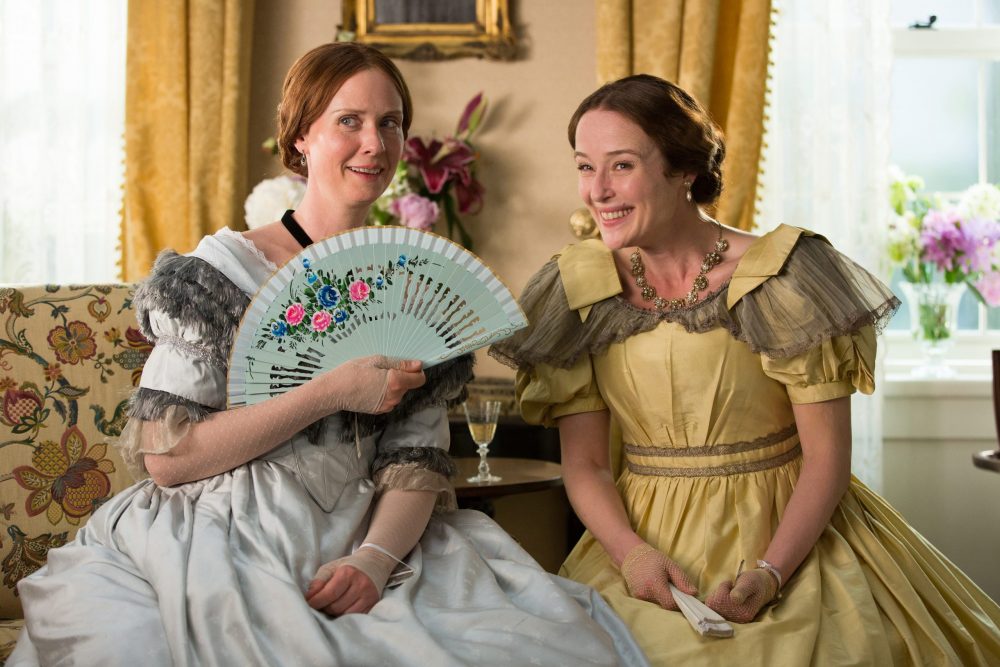The film starring Cynthia Nixon takes a surprising look at Emily Dickinson’s life.
There’s a lot to love about Emily Dickinson, and about Terence Davies’ cinematic biography, A Quiet Passion.
The reclusive American poet is considered a great literary treasure, and although severely constrained by the limitations placed on women in the 19th century, Dickinson found her own niche in the medium of poetry and became one of the most celebrated American literary voices.
For someone who lived a life of confinement she found a way to examine many aspects of existence, both physical and metaphysical, and through intense thought and feeling create 1,800 brilliant and impactful poems that burn brightly even today.
A Quiet Passion takes us into Dickinson’s life, from her schooldays where she firmly rejects a path of evangelism and admits to her love of art, music and beauty, to her daily existence in the family home in Amherst, Massachusetts. During her mature life we see her devoting time to her family, socializing, and most importantly, writing, which she does in the middle of the night when she is alone with her thoughts and won’t be interrupted.
But her existence isn’t without its challenges; she struggles to obey her father’s wishes, she manages a chronic illness, and while she has a poem published here and there, the edits are not to her liking. She does not experience success or fame during her lifetime. To many, such an existence would seem unthinkable, dull, painful, wasted.
But A Quiet Passion shows us that, in spite of its limitations, Dickinson’s life was bejeweled with tiny moments of pleasure and joy, heartache and contrast, all of which informed her work and gave it meaning.
According to Davies, who directs this film with immaculate precision, Emily Dickinson (portrayed by an incandescent Cynthia Nixon) was a headstrong and fiery rebel, a cultural iconoclast who anticipated the thirst for individualism that would eventually come to characterize American culture.
America’s most cherished female poet railed against the chains of religious servitude and the puritan code; evangelism and marriage were meant to legitimize her as a woman, but she instead sought fulfillment and transcendence in beauty and the art that could be made from observing it. Sacrilege was not her aim. She was merely “meticulously guarding the independence of [her] soul.”
In this way, Dickinson has something in common with feminists and lesbians, queer and transgender people, who resist the demand to conform, refuse what society tells them they are or ought to be, and follow their own innate orthodoxies, seeking out and creating marginal texts that inspire them — even in the face of disapproval. Dickinson passionately identified with the English novelist Emily Brontë, and had much in common with her; for both women, language and literature were conduits for a desire never physically known.
While Dickinson was by most accounts platonically straight and allegedly harbored crushes on men, there have been theories to the contrary. A Quiet Passion maintains that she was heterosexual, and does not delve into the possibly lesbian aspect of her nature or her poetry.
The film does make clear that she relished and cherished the intimate company of women — especially her lovely and devoted sister Vinnie (Jennifer Ehle); her loving sister-in-law Susan (Jodhi May), who adores Dickinson (passionately but chastely, in spite of this letter Emily wrote to ‘Susie’); and their saucy friend, the arch and Austenesque Miss Buffam (Catherine Bailey). Women loving each other is, in this era, part and parcel of domestic life, whereas loving men is a social contract that requires the intervention of religion, the patriarchy, and a negotiation and commitment that is beyond the reach of Dickinson.
While she may have fantasized about suitors, she turned actual gentleman callers away from her door.
Dickinson’s self-confident joy and the almost fanatical pleasure she took in admiring the shape of all things, from feminine wordplay to a single metaphysical thought, to the shape of a man’s head — this is the “quiet passion” that sustains her during her life. But life, it appears, shortchanges her and as the years go by her unhappiness, bitterness and anger increase. No marriage, no children, no faith. It’s a fate that also used to be the lot of “spinsters” and queers.
Older lesbians know all too well the price paid for trailblazing rebellion and individuality. Dickinson suffered greatly to produce a body of work while deferring the pleasures of her own body. Davies, a gay man of middle-age and of Catholic upbringing, has said that being gay and irreligious compromised his own happiness.
That is his view and in A Quiet Passion, we feel him identify strongly with Dickinson. This film is also a fitting continuation of his own work, which includes Distant Voices, Still Lives and The House of Mirth — films that have a knack of meticulously examining the fabric of existence, even at its most unfulfilling, repressive, and tragic.
But A Quiet Passion is also a celebration of and argument for authenticity and self-determination in women. There’s something about this beautiful and painful film that makes me want to grab my life with both hands and never let it go, not for a moment.
